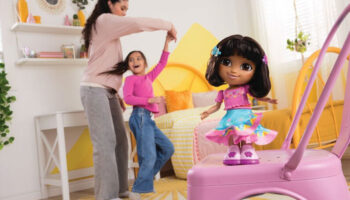Rubik’s Capture co-inventor Richard Heayes discusses developing, pitching and tweaking the idea

Thanks for joining us, Rich; always a pleasure. As you know, we’ve been taking a really round look at one of your new games, Rubik’s Capture. Can you tell us, in your own words, the aim of the game?
Sure! I think the best way to explain it is it is like Word Search but with colours. You flip a card and try to find a 3×3 grid that matches the rules of that card, slam your plastic Rubik’s grid onto the board and capture it!
And when you say “Rules of the card”…
Broadly speaking, there are times when you’re looking to match the exact pattern as it’s specified by the card… Other times, you also need to avoid colours marked with an X. So an example might be that the grid need to show two white squares, and two yellow – but no reds.

Got it. As I recall, this was one of a number of ideas you showed at a Rubik’s Design Challenge organised by Mojo Nation. How did you find the brief?
Rubik’s is a great brand with such an iconic visual look but it doesn’t have any character cues to build off. The iconic cube and it’s colours ARE the character so it’s about finding innovative ways to bring that to life.
What was your biggest concern about the brief?
You never know what a brand is REALLY looking for – or what else they’ve seen. I was working with Amanda Birkinshaw on this, and we’ve both had many meetings where the brief has been, “I’ll know it when I see it!”
Right.It’s also fair to say that Rubik’s has already done countless products over the years… So once you get the brief, how far do you go in exploring what’s already been done before you start thinking about what you can do?
Happily, Amanda and I already knew about quite a few existing products between us. We also knew, quite early on, that we wanted to explore a multiplayer experience.

For what reason?
We felt that was an area where there was still room to innovate, especially as many products in the Rubik’s range centre around an individual experience.
In terms of the innovation then, do you remember how many ideas you had in relation to how many you developed and pitched?
We came up with 12, but narrowed it down to four at the pitch.
And as regards coming up with those 12 ideas, where did you start?
In this case, we worked to identify the key attributes of the brand. Rubik’s
has six colours. It has a feeling of challenge and puzzle play. It also has a grid pattern!
That’s easily overlooked, though! That black grid is on every face of every Rubik’s Cube in the world – but I’m not sure many people would see it as an attribute of the Cube.
Well, maybe not! But part of the challenge was to look at opportunities outside the original Cube. We wanted our games to be visually obvious as a Rubik’s product, but multiplayer and mass market. We also wanted them to be playable by a wide age group such as you find with an immediate family setting.

Great! And after you had the ideas that fitted with your view of the key attributes, how did you decide which were worth pursuing?
We went with those we felt were most fun, most on brand, and those we felt were able to be manufactured cost effectively should they go ahead. We also considered which of the ideas we would be able to prototype in the time available.
Excellent! Did you make up prototypes for everything you wanted to pitch, then? Or were some ideas so simple that you could just show a graphic?
We made prototypes for all the ideas. We didn’t go crazy, though! For example, with Capture, I think we only made ten cards or so, just to get across the idea of the gameplay. It might have been ten cards, it might have been a dozen… It was certainly a reasonably small packet, which worked fine. My feeling is that it always helps to have a prototype at a pitch where possible, even if it isn’t polished… As long as it gets across the basic play pattern.
When you pitched the idea on the day, how confident were you it would go somewhere?
We felt confident that at least one of the ideas would make the cut with Rubik’s. In the end, we had two ideas get through to selection – and Capture made it all the way to a contract.

I love it when we can be absolutely concrete on figures like this, so I’m going to recap for any new inventors reading… You got the brief. You worked up 12 ideas. Of those 12, you prototyped and pitched four. Of those four, Rubik’s liked two… And of those two, one got to market. Is that right?
That’s right!
That’s fantastically insightful. And probably quite a high success ratio! Out of interest, were any of the other ideas useful outside the context of Rubik’s?
Yes, I think there are opportunities for some of them to exist outside the Rubik’s brand. They’d need a slightly different design but the play patterns are solid.
Alright, we need to start wrapping this up, Rich, but let me ask you a couple more things… Without giving away more than you should, what was the process beyond the day itself? How smoothly did things progress?
The post-meeting discussions went fairly smoothly. The way we pitched it, though, the original game board was a 12×12 grid. The initial feedback from Rubik’s asked if we could we make it even more challenging. So we created a 14×14 grid, and also made the board double sided.

And did that affect – well, I guess it must’ve done – the pack of cards?
Yes – we redesigned the deck. We created 60 cards that worked with both grids… Then there was a request for a travel version of the game, so we designed a new double sided board – and new cards for that too! That way, the experience of the travel game wasn’t t just a smaller version of the large game. They’re unique challenges.
Lastly, then: at what point did you find out it Rubik’s Capture was a definite go?
You know, it’s only when a contract is signed that you have a fairly good idea a product will launch. But it’s not until the production line starts rolling that you really know! With Capture, the added complication was that Spin Master bought the Rubik’s brand while the game was in development! That meant the product had to go through the Spin Master filter as well. Luckily, they liked the game just as much as Rubik’s!
Wonderful! Brilliant. Listen, Rich, I know you’re incredibly busy and have had to take time out to do this so let me thank you most sincerely.

–
To stay in the loop with the latest news, interviews and features from the world of toy and game design, sign up to our weekly newsletter here






















